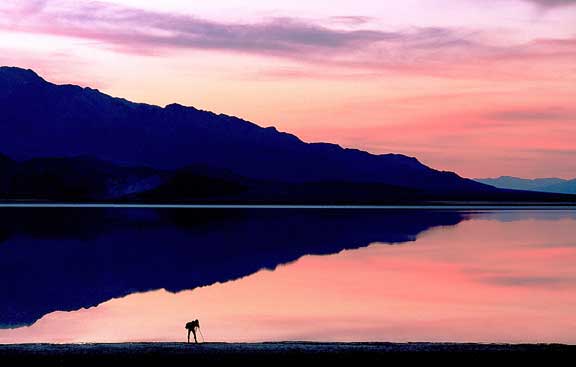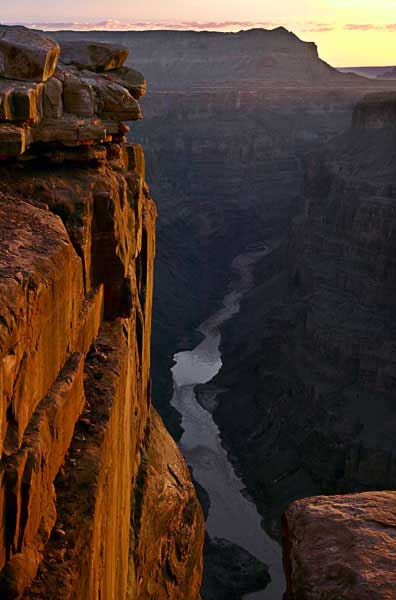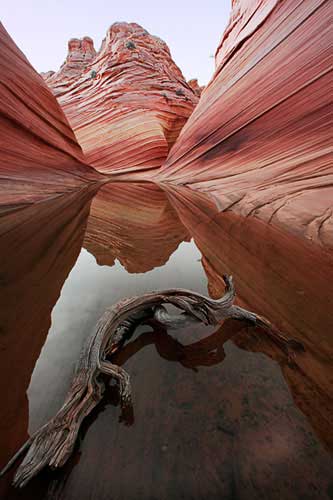Part II: The Business Aspect of Photography

Photographer at Badwater (c) Steve Kossack
About The Image: I use this as my signature image. I think it represents all of us that do and love doing landscape photography. Done in Death Valley in 1997 and one of several images made that evening. The detail in the cliffs just above the water line is key and it was several years before I was satisfied with a print.
JM: Please describe what your business looks like currently - what are your primary sources of income photographically?
SK: My business consists of my workshops
workshops and the DVD sales of Steve Kossack Photographing
The Great American Landscape. Both are the result of circumstance and interaction with people that I have met while doing landscape photography. Through the years, many relationships have developed and grown.
I never intended to do photography as a business and I'm very careful not to let the fact that it has become one interfere with my desire to do and share landscape photography. My workshops developed slowly and remain small in both the amount I do and the group size. I'm proud to say that I have over a 70% return of participants.
JM: When was the first time you were published?
SK: When I was still in school a graphic arts design firm came looking for images for a CD cover. The subject was fire and they viewed somewhere a couple of images that I had made while working on, and participating in, a fireworks display with a company that did pyrotechnics. Some of the rockets were hand fired and I was allowed to move freely while the show was being preformed. It was quite exciting! The selling price was not memorable and I never followed the fate of that CD. I have no idea what became of the group but I still have and treasure the CDs. I'm sure if they were opening for the Rolling Stones today, I'd know :-)
Like all things today, with the growing popularity of the internet, being published is somewhat easier today. I had an image on a bible early on. Many ad campaigns have used my work. Since my main emphasis is on field photography both with and without my workshops, I've been fortunate not to have to shoot to sell my images, I don't do much to promote them but do enjoy seeing them elsewhere. My inclusion with the names in the
Singh-Ray Filters Gallery is a real thrill for me. For more information please visit:
http://singh-ray.com/gallery/galleryi.html.JM: What is it you wish to provide in your workshops?
SK: My workshops were the result of people asking me where my images were made and then asking if I could show them. I started with one person and have kept my group size small over the years so as to keep the feel in the same sprit as when I began.
I think that the experience is enhanced with personal care and attention to detail. I go to great lengths to see that participants are taken care of from the time they arrive until departure. Everything from lodging, transportation to the actual shooting locations. Having said this, I have become a travel agent, tour guide and photography instructor. I put in a great amount of research and scouting. The time taken on the actual workshop is small in comparison, but I see the results during and after. I know this is how it must and should be done.
I find that I like people who do landscape photography at all levels. I enjoy showing great places to photograph and seeing the reaction to them. I want my participants to understand a little bit about what they are seeing and most of all to share in a group atmosphere. As artists, most of us do this endeavor alone. It's a solitary sport, as I like to say. So when I see people making friends and exchanging thoughts and ideas, I think I've provided something unique. We work very hard, put in long hours and go home with a lot accomplished. Most come for the photography but they all come back for the fun! I'm driven by the positive reaction to these workshops and the will to do more. The business element does not enter into it on this level.

Toroweep Sunrise (c) Steve Kossak
About the Image: This classic image was in the making for years. I had viewed many extraordinary images of this area for a long time but was never able to make one of my own that compared. Because of my fear of heights, I could not bring myself to get where I wanted to be but finally made it!
JM: When doing a 5 day workshop, I am SURE that you have had periods where the weather has not cooperated. How do you help 'make it happen' with your participants?
SK: I have always viewed my workshops as introductions to the area we are covering. I pick an area and explore it in depth. I take my workshops only to places where I have been myself many times and only to places where I have been successful making images. That's what I would expect from a workshop and think my participants deserve. If I've done my job properly, I think they will want to return either on a return workshop or individually - so the itinerary usually goes as scheduled (even during inclement weather). When it's your day at Disneyland, you go! I learned my locations by scouting. A first trip into an area is for me is a scouting trip. If the conditions are conducive to photography, you shoot and if not you still have learned something that will serve you well at another time. It think this is an important lesson and I practice it both by myself and on workshops.
JM: How does your website play into your business?
SK: The website is the outgrowth of the workshops. Started simply as a place to list the workshops, it has grown something that I enjoy when I'm here. I did not want a website for a long time. I thought it would keep me from doing what I like most, that being in the field, but I now find enough time to update it frequently and I do like the response it generates. What the website has done as a byproduct is given me the opportunity to write about what I do and how I feel about it. I've never been much interested in the websites that push products or seem to be concerned about popularity and I see mine as a place where we can share the passion and thought process involved in doing landscape photography. With the introduction of the DVD series, Steve Kossack Photographing the Great American Landscape, the website has now become the base for it's sales also.
JM: Have you thought about how you would like to further develop the website?
SK: I'm always looking for a way to highlight the photographer. I'm not so much interested in the equipment or even the image for that matter. I like and appreciate what goes into the mental aspect and execution of the process of doing and making landscape photography in the field. The workings of the photographer are of far more interest to me than the workings of the equipment or the equipment manufacturers. People that can talk about their passion are the heart of the matter for me. I'd love to see the website showcase this.
JM: What are your current business goals?
SK: I did not and could not have envisioned a business that came from photography. I see the same odds as everyone else. Those odds are hugely stacked against. One of the great poets said something like, "lucky is the man who's hobby is his profession." Someone also said "without bad luck, I'd have no luck at all." I consider myself most fortunate to do what I do, an how I do it. I tell people that, "I like what I do and I hope it shows!" Doing more of the same in the future would be just fine with me. The next DVD issue is Death Valley with Canyonlands to follow. Workshops are in place for next year. For more information please visit:
http://stevekossack.com/workshops/workshops.htmJM: How did running the family business impact you in your photographic work?
SK: Once I came to realize that what I do had become a business, I had very little problem in running it that way. My prior experience was very helpful. The toughest aspect was and continues to be separating myself from the two. I find that once I have everything in place business wise, I can then revert back to being a landscape photographer/instructor/guide. I can not be both at the same time!
JM: What advice do you have for people in terms of developing a successful financial strategy for running a photographic business?
SK: Art and business have absolutely nothing in common as I see it. They usually don't mix well and I think for good reason. When I ran a previous business that was not photography related, it was just that, a business. The means to the end was only a matter of physically doing the work that brought in the money. Nothing in the creative process works that way for me. I have known a few that look into a viewfinder and see dollar signs, but I never have. If the thought process were bogged down with cost of equipment, time involved and income, I know I would not do this at all!
I think most of us do photography as passion, art and pleasure. Not necessarily in that order but the point is that this is not how a business is usually viewed or handled. I'm forced to separate my field photography from the bookkeeping and other chores that make it successful. It's a dance of the hats that is sometimes very uncomfortable but extremely necessary. Having been in business before photography is a great help. It only works for me if the pieces are in place first, making the rest possible.
While in the field, the dedication and discipline it takes to make a successful workshop is intense. Usually five days in length, most every minute of the itinerary is planned. My thought is to get in as many setups as possible in as many varied locations as possible in the time allowed. Most people have limited time and want to make the most of the experience. This means very long days with very short nights between those sunsets and sunrises. We work hard and play hard. Most come back with thousands of frames, and as mentioned previously, most come back!
The routine is sometimes a hard pace to keep up with. Demanding both physically and mentally, they drain energy but are most satisfying. Leaving and coming home are facts that are both dreaded and looked forward to. I find the lifestyle exciting.

Top Rock (c) Steve Kossak
About the Image: I've been out and lead workshops to the Wave formation in the Vermillion Wilderness on the Arizona, Utah border in all seasons. My most hoped for situation is water in the entrance. The reflection has many possibilities and I think this one is a fine example.
JM: We have not talked much about your DVD. Do you want to talk about it a bit more? How does it compliment your workshops, if at all?
SK: The DVD was born out of an idea mostly of my partner's expertise. He owns a video production company and had been a participant on many of my workshops. Together we have created a project that pretty much presents the workshop experience. You can view it as a step by step photo shoot of an area or a casual photo travel guide. We have provided maps an detailed explanations of where we are, what we are planning and what we hope to come away with and how. We show the places, the time, the people and equipment. I think it's a workshop in a box in many ways but the production quality is that of a first class travelogue as well. We concentrate on the the art of doing landscape photography but at the same time add enough technique and gear talk to be of interest to all photographers. We are very proud of what we offer and we don't see anything quite like it out there today.
We are very gratified at the reception to the DVD. Our advertising for it has begun in Outdoor Photographer Magazine and we continue to believe that if people know of it they will find help and inspiration from it. We've put a lot in it and into it and there are two more in the working stages right now. This along with the associated workshops present me with what I see as a full plate for the foreseeable future.
JM: Prior to your DVD and recent advertising, how was word about your workshop getting out to the mass market?
SK: Word of mouth has been my main source of people for my workshops from the beginning. It started slowly and continued to build. I've always wanted to keep the workshops small and don't need a lot of people to make them work, just the right ones. To learn more about this, you can visit:
http://stevekossack.com/others.htm. In the beginning I assisted others that already had a following. I saw what I thought I could improve the workshop experience and concentrated on what I thought were my strengths and what people seemed to respond to. I started with my assumption that I personally, would never take a workshop and tried to eliminate all the reasons why. Above all, I have always listened. I listened to everyone, and then tried to bring to my operation and art, that what I thought had merit and what I thought I could do.
As always, we encourage you to come join the community and to be participants in the
forums.Just a friendly reminder that this article is Copyright 2005, James Morrissey, and may not, in part or in whole, be reproduced in any electronic or printed medium without prior permission from the author. The images in this article are the property of Steve Kossack and have been licensed to James Morrissey and the NWP Photo Forum for the purpose of this interview.